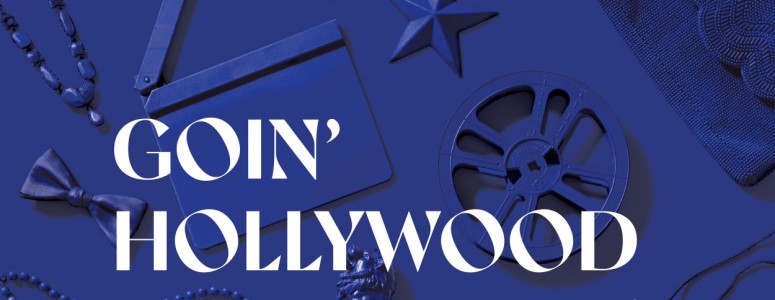Was February 10, 2023 a significant date in American history?
Granted, on that day, Adidas announced that it expected to lose $1.3 billion in sales after dropping Kanye West. Nevertheless, that wasn’t on the minds of bookwriter-lyricist Stephen Cole and composer David Krane when they wrote their original musical GOIN’ HOLLYWOOD.
The show, which recently had a superb production and run at the WaterTower Theatre in Addison, Texas, eventually showed theatergoers that Cole had a very good reason for being so specific. Audiences had to wait a while before they learned his motivation; when they did, they showed audible delight.
That secret, however, would only be divulged after the attendees had met Broadway songwriters Chandler and Stein – names that not-so-incidentally scan perfectly with Comden and Green.
Chandler’s first name is Alice; she’ll soon find herself in a rabbit hole as unexpected as Lewis Carroll’s namesake. Stein is Garson, who’s annoyed every time he’s in a French restaurant and is mistaken for a waiter.
(His being a Jew will pose a few other issues.)
It’s Alice’s 30th birthday, which “is nothing to celebrate.” The two soon have more to bemoan, for a text informs them that their producer has dropped the option on their new musical. She wishes that they “were heading out to Hollywood away from the theatre to write movie musicals.”
Well, in musicals, such wishes often come through, and this is no exception.
When they arrive in 1948, you may wonder why the time travel device was needed at all. Why not just start in 1948 and let the story proceed from there?
Cole’s ahead of you. This was the time of the House UnAmerican Activities Committee, the Blacklist and the jailed Hollywood 10. Imagine, then, what problems our heroes will endure when their pasts are scrutinized and there’s no record of their birth, schooling or work history. Who are they? Who were they? What are they hiding?
In Back to the Future Part Two, the nefarious Biff secures a sports encyclopedia that lists the winners of late 20th century games. This foreknowledge yields Biff a fortune when he returns to 1955 and bets and always wins. Similarly speaking, Cole could have had Alice and Garson “create” the much-heralded Singin’ in the Rain and take home Oscars for An American in Paris. No — they’re honorable and want the challenge and pleasure of doing the creating. That makes us like and root for them.
Cole is not only a meticulous historian whose research seems all-encompassing, but he also knows how to weave that history into the perfect places. Thus comes the complications that the government was cracking down on studio monopolies; the selling of studios’ assets were true concerns; the advent of TV was rearing its electronic head and threatening to behead the film industry.
Still, Alice and Garson are fortunate to find an ally in director A.J. Engerman, who gives them a break because “you two write like you’re having sex.” How Garson wishes they would! But that’s another story that Cole eventually resolves in a most convincing and satisfactory way.
With a woman in the writers’ room, the studio’s staff scribes are quick to dispatch Alice for coffee and bagels. Do you expect Alice to unleash a tirade in song? No — just as Sondheim has Sweeney sing a beautiful song while he’s slitting throats, Cole has Alice accentuate the positive with the awareness that future women will bring in projects that will be green-lit and won’t just be sent out for salad greens.
However, Alice doesn’t foresee what many women sadly still face today. It leads to a moment of tension that lasts so long that no, you couldn’t cut it with a knife, for you’d need a machete with Excalibur as a back-up.
Cole wrote it well, but director Gabriel Barre deserves a good deal of credit for making that tension ultra-tense. Barre, whose direction of Andrew Lippa’s THE WILD PARTY still remains a vivid memory nearly a quarter-century later, once again provides a fast-moving and compelling production. In maneuvering a cast of 17 (which is more than some Broadway musicals have), Barre beautifully blocked his performers so to yield many handsome stage pictures.
Alice and Garson must inevitably deal with the thorny politics of the day. “We can’t protest,” Alice insists. “We have to finish the Esther Williams script!” Theatergoers of a certain age will delight in hearing the stars of yesteryear mentioned — Gene Kelly and Judy Garland, of course — but they’ll be delighted to be reminded of the less- celebrated. (Vera Rhuba Ralston, anyone?)
So in a year in which Hollywood released such excellent and uplifting musicals as UP IN CENTRAL PARK and EASTER PARADE, what do our heroes write? A musical about “Naming Names.” Says Alice, “We’ll be so clever and satirical that they won’t even notice we’re subversive.”
That’s much easier said than sung and could have resulted in a terrible misstep. Still, BMI Musical Theatre Workshop founder and guru Lehman Engel often advised his students to “look for humor in dark places,” and Cole found a good deal of black comedy in the blacklist. His lyrics here are so cutting edge that it’s a wonder that the performers didn’t get paper cuts from the sheet music.
David Krane’s music is exceptional on a number of levels. When matters get dark, he provides film noir; when they lighten up, he gives pin-point accurate 1940s swing and boogie-woogie. Krane has also composed an Act One closer that you would have whistled through the entire intermission as well as a rousing eleven o’clock number that rates an 11 on a ten-scale. For those who think that an audience only shouts “Whoos!” after rock numbers, the WaterTower crowd proved them wrong.
Even more impressive is that Krane provided arrangements as well as orchestrations (the latter in conjunction with Bruce Coughlin). The close harmony is not to die for, but to live for.
Shane Peterman, the WaterTower’s producing artistic director, may not have broken his organization’s bank on this one, but he must have extensively dented it. True, the orchestra didn’t have the number of musicians that Glenn Miller once offered in the ‘40s, but excellent conductor Lawrence Yurman (who not just tickled the ivories, but caressed them, too) had eight colleagues in his band. (Believe it or not, that’s as many or more than some Broadway musicals have sported).
Lord knows how many arduous hours costume designers Sarah Mosher, Paige Triplett and their staff searched through every thrift shop in Dallas county to get pin-point perfect period costumes, down to Garson’s elaborately decorated tie that was then in fashion. Bob Lavallee’s scrims and sets were imaginative, enhanced by the famous Hollywood sign perched high above the action. Samuel Rushen’s plentiful projections weren’t limited to slides, but offered vintage film clips that reminded those who get TCM to be grateful that their cable company provides it.
Alison Whitehurst certainly wasn’t cast as Alice because her first name resembles the character. She captured her sweet nature but became ram-rod resolute when the occasion (often) called for it. Brian Hathaway has a character man’s looks that were ideal for Garson, but when he showed his romantic side, he did it convincingly. Better still, he eventually had a strong number in which he graduated from funny guy to hero, and he skillfully accomplished it.
Three others stood out. As A.J., Cooper Grodin expertly traveled from a flying-high studio player to a downward-spiral victim. Stan Graner (with Cole’s script as help) avoided being a one-dimensional CEO which L.B. Mayer could have become in lesser hands. What’s also impressive is that he held on to his dignity even while fully aware of the serious talk that he’d be replaced. (So what that he’s the second “M” in M-G-M is “Mayer”? That’s show business, folks.)
Movie musicals of yore always had a sidekick to kick someone into action or smooth out matters. Here’s it was Nancy, a Girl Friday for every day of the week. In playing her, Jocelyn Hansen helped out — true, not totally altruistically, for she did want romance. Did she get it? Oh, you’ve seen 1940s’ musical movies, so you know the answer. What Hansen did get, however, was that supercharged burst of applause that audiences ramp up to show their show-long appreciation. Truth to tell, so did all the other leads.
And speaking of applause, writers know they’re succeeding when the audience enthusiastically claps hands after a scene that doesn’t end with a song, but with a line of dialogue. It happened here.
With New York theaters as large as the Imperial and as modest as the Schoenfeld are suddenly and unexpectedly empty, GOIN’ HOLLYWOOD should be goin’ to Broadway.




